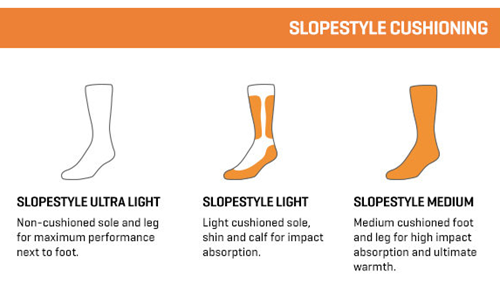
1. Wear the Right Socks
Wearing the right socks makes all the difference in the world. Wool socks will keep your feet warm, dry, and comfortable. How, you ask? Wearing a thin sock, in a properly fit boot allows your foot to breath and be gripped correctly by the liner and the shell. If you have too much material, or wrinkles in your socks, your circulation in your foot will be compromised. With the help of Smartwool, we’ve pulled together a quick science lesson:
Breathability: The more breathable a product is the better it is at removing moisture from the space between your skin and the fabric. As your body heats up, the moisture vapors will be absorbed by the wool fiber and released to the drier environment outside of the fabric, releasing heat and keeping feet dry and comfortable.
Moisture: A Merino wool fiber can absorb and retain up to 30% of its own weight in moisture and still feel dry to the touch.
Warming: Wool has a natural crimp to it that helps it trap more dead air than any other fiber. Dead air is an amazing insulator and provides a buffer against the cold.
Itch: Wool is infamous for being an itchy fabric. Merino wool, however, is a different story.
The itchiness you feel with wool is determined by the diameter of the fibers used. Larger, broader fibers are less flexible and have less ability to bend, which results in a prick when pressed against the skin, causing the sensation of itch. Merino wool is able to ditch the itch thanks to its fiber’s smaller diameter, or being “finer”. These fibers are more flexible and softly bend when pressed against the skin and, therefore, don’t itch like other wool.
Smartwool has created an ingenious fit chart to determine the best sock for you. After all, the way the sock fits inside your boot makes all the difference in the world.
Also, the only thing inside your boot should be your socks; do not include your pants base layer. Including more layers than your socks can change the way your boots and socks fit. Extra seams can cause pressure points which may increase the likelihood of pain points, a “pins and needles” sensation, or your feet falling asleep.
- Invest In Good Insoles
Insoles, or footbeds, can make or break the fit of your ski boot. Insoles are often the most often overlooked item when purchasing a ski boot! A good insole helps in a number of ways. Do you feel pain in the balls of your feet? Does your arch hurt or feel tired at the end of a day on the slopes? Do you have a slow turning response or trouble evenly pressing on your edges throughout the entire turn?
If you answered yes to any of the above, you may need a new insole. All boots come with a foam insole, but this does not offer the adequate support you need to be the best skier you can be. Insoles provide even support and pressure between your foot and the boot and complete the connection with your foot and ski boot, allowing you to be more comfortable and have more control. Insoles will keep your foot in the correct position within your boot, which gives you the control of your boot, thus, control of your skis. Insoles are also beneficial to those who have weak arches or a pronating ankle. They help stabilize the foot and ankle in a neutral position allowing for more control!